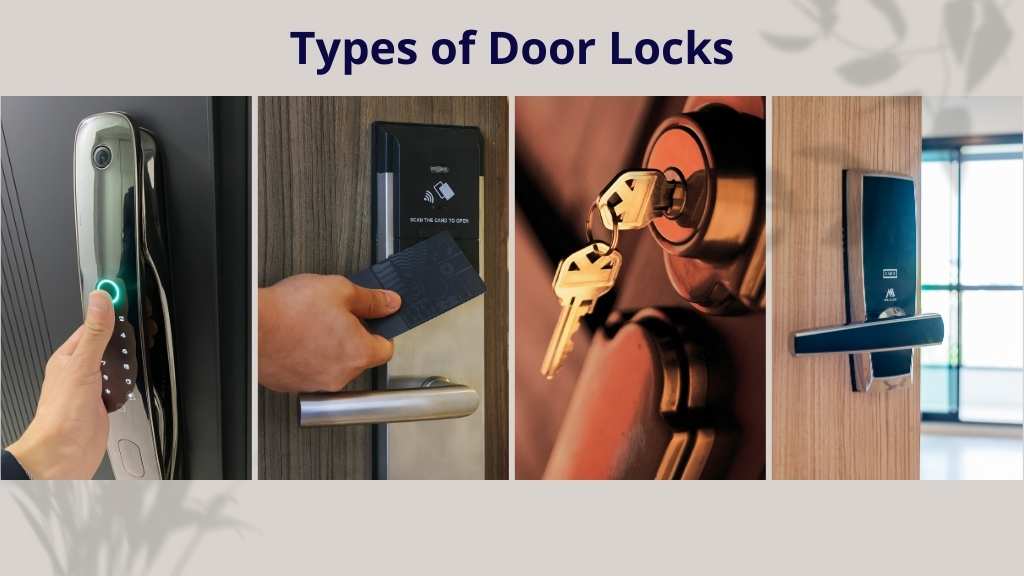
In a world where safety is paramount, door locks play a pivotal role in protecting your home. Understanding the types of door locks available is essential for bolstering your home security. In this guide, we will explore various door lock options and help you make an informed choice.
Understanding Types of Door Lock Systems
Let’s talk about the stuff that makes door locks work. Before we dive into the types of door locks you might need, it’s helpful to know about the parts inside these locks. Understanding this hardware can help you choose the right lock for your needs.
1. Cylinders
A cylinder is the main part of a lock that you put your key into. Inside it, there are little pins that work like tiny springs. When you put your key in, it has a unique shape that pushes these pins up to a certain level. If you use the right key, it pushes the pins to just the right spots, and that makes the lock open up. This, in turn, lets the door unlock and open when you turn the key.
2. Bolts and Latches
To open or close a door, we use a special part inside the door called a bolt. This bolt is usually made of metal and it helps to keep the door and the frame together. Now, there are two types of door lock bolts:
- Spring bolt: The spring bolt works a bit like a spring-loaded clip. When you push or pull the door, the spring inside the bolt helps it move to either lock or unlock the door. It’s kind of like how a click pen works.
- Deadbolt: On the other hand, the deadbolt doesn’t use a spring. Instead, it uses a key or a knob on the door. You turn the key or knob to lock or unlock the door. Deadbolts are usually considered more secure compared to spring bolts because they are harder to force open.
3. Strike Plates
Imagine your lock is like a puzzle piece that fits into a square hole. This square hole is called a “box.” The strike plate is the other part of the puzzle, and it’s attached to the door frame. Its job is to guide the lock’s bolt into the box and keep your door securely closed.
Now, there are also fancy new locks in the market. These high-tech locks use smart technology to make sure your home is safe. They run on electricity and can be unlocked in different ways, like using a special code on a keypad or scanning your fingerprints or eyes. These advanced locks are all about keeping your place super secure!
36 Different Types Of Door Locks: Pick Your Pick!
1. Deadbolt Locks
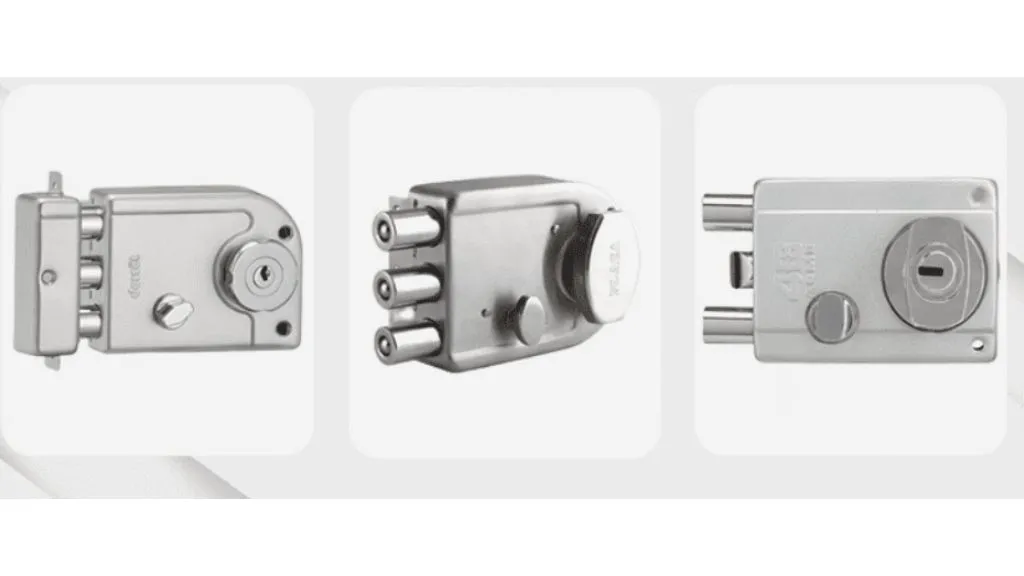
Deadbolt locks are a classic choice for securing your entryways. Here are some of the different types of deadlocks you can choose from:
1.1 Single Cylinder Deadbolt: This type of deadbolt has a keyhole on one side and a thumb turn on the other. You use a key to lock and unlock it from the outside, while inside, you can simply turn the thumb to lock or unlock.
1.2 Double Cylinder Deadbolt: This deadbolt has keyholes on both sides, so you need a key to lock or unlock it from both the inside and the outside. It provides extra security but can be a safety concern as you need a key to exit, which may be difficult in emergencies.
1.3 Keyless Deadbolt: Keyless deadbolts use codes or electronic mechanisms, like a keypad or a smart lock, to lock and unlock without the need for physical keys. Some models may also have key backup options.
1.4 Jimmy-Proof Deadbolt: These types of door locks are surface-mounted on the door and frame, making it resistant to forced entry using tools like a crowbar. Lock and unlock it using a key or thumb turn like a single-cylinder deadbolt.
1.5 Vertical Deadbolt: Vertical deadbolts are mounted vertically on the door and frame, providing added security against forced entry. Operate them using a key or thumb turn, much like a single-cylinder deadbolt.
1.6 Rim Deadbolt: These deadbolts are installed on the inside surface of the door. They lock into a strike plate on the door frame. Turn a knob or thumb turn to lock and unlock it.
1.7 Mortise Deadbolt: Mortise deadbolts are installed within a pocket (mortise) in the door and require a key to lock and unlock.
2. Knob Locks
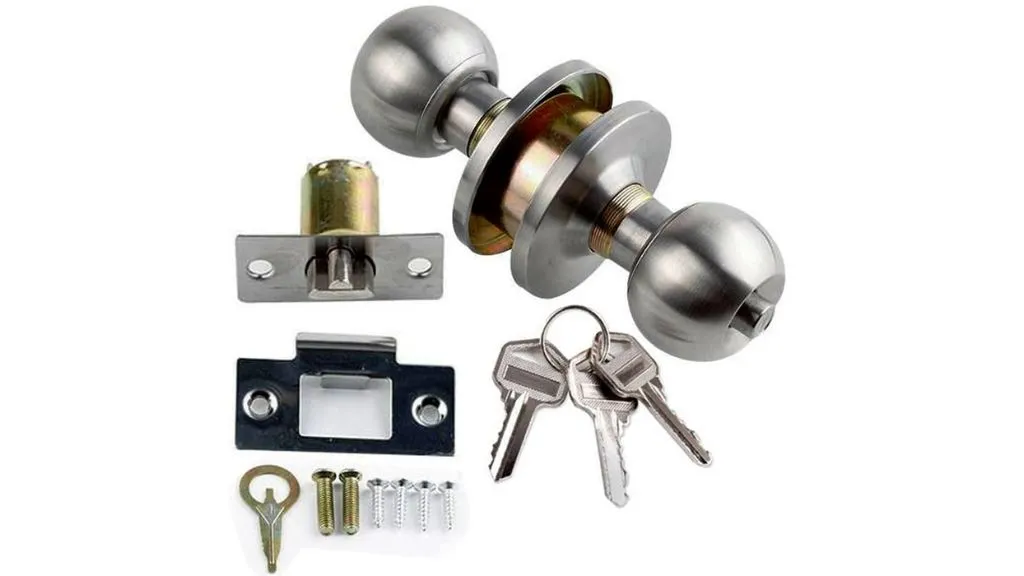
Knob locks are commonly found on both interior and exterior doors. They offer ease of use but may not provide the highest level of security. If you need a knob lock in your space, consider these types:
2.1 Keyed Knob Locks: You insert the key into the keyhole on the knob, turn it, and the door unlocks.
2.2 Privacy Knob Locks: Privacy knob locks have a push-button or turn-button on one side and a small hole on the other. You can lock the door by pressing or turning the button, and it can be unlocked from the outside with a special tool or a small pin. These locks are commonly used in bathrooms or bedrooms where privacy is essential. They shouldn’t be used as the primary security lock for external doors.
2.3 Combination Knob Locks: These knobs require you to input a combination of numbers or a code to unlock the door. Some use a digital keypad, while others have a rotating dial with numbers.
2.4 Keyless Entry Knob Locks: Keyless entry knobs use electronic keypads or even smartphone apps to unlock the door. You enter a code or use your smartphone to gain access.
3. Smart Locks
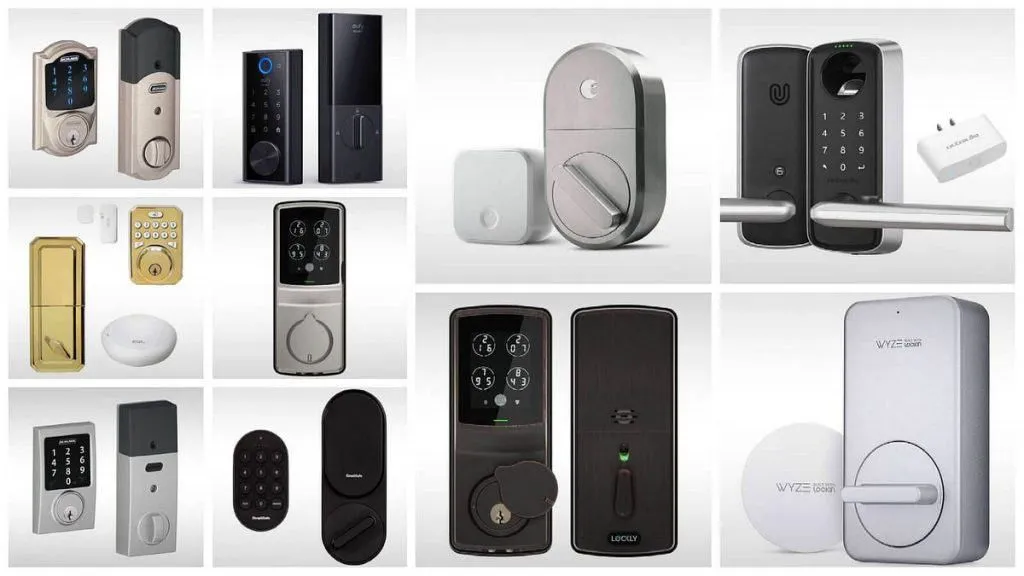
Smart locks are a modern twist on traditional locks, and they come in various types based on their mechanisms. Here’s a breakdown of the different types and how you can use them:
3.1 Keyless Entry Smart Locks: These types of door locks do away with physical keys entirely. You unlock them using methods like PIN codes, fingerprint recognition, or even your smartphone.
3.2 Bluetooth Smart Locks: When your smartphone is within Bluetooth range of the lock, it automatically detects your device and allows you to unlock the door through a dedicated app. This is convenient for home or small office use.
3.3 Wi-Fi Smart Locks: You can lock or unlock the door using a smartphone app from virtually anywhere. Some Wi-Fi locks also integrate with voice assistants like Amazon Alexa or Google Assistant, allowing you to control them using voice commands.
3.4 Z-Wave and Zigbee Smart Locks: These locks use Z-Wave or Zigbee wireless protocols to connect to a smart home hub, which then communicates with your smartphone or other smart devices.
3.5 Biometric Smart Locks: To unlock a biometric smart lock, you simply provide your authorized biometric data, such as placing your finger on a scanner. These locks offer a high level of security and convenience.
4. Mortise Locks
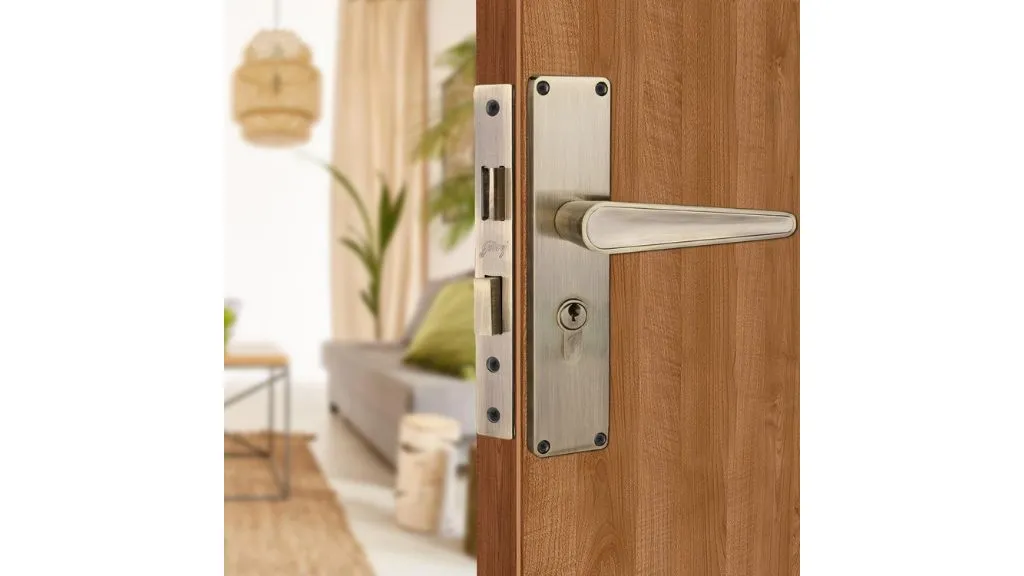
Mortise locks are known for their durability and strength. They come in several different mechanisms, each with its unique features and applications:
4.1 Mortise Cylinder Locks: These locks have a cylinder that can be replaced or re-keyed easily. Mortise cylinder locks are versatile and can be used on various types of doors, including wooden and metal ones.
4.2 Mortise Sash Locks: Sash locks have a latch and a deadbolt. The latch can be operated with a door handle, and the deadbolt is engaged by turning a key.
4.3 Mortise Hookbolt Locks: Hookbolt locks feature a hook-shaped bolt that locks into a strike plate. This design makes them resistant to prying and forced entry.
5. Cam Locks
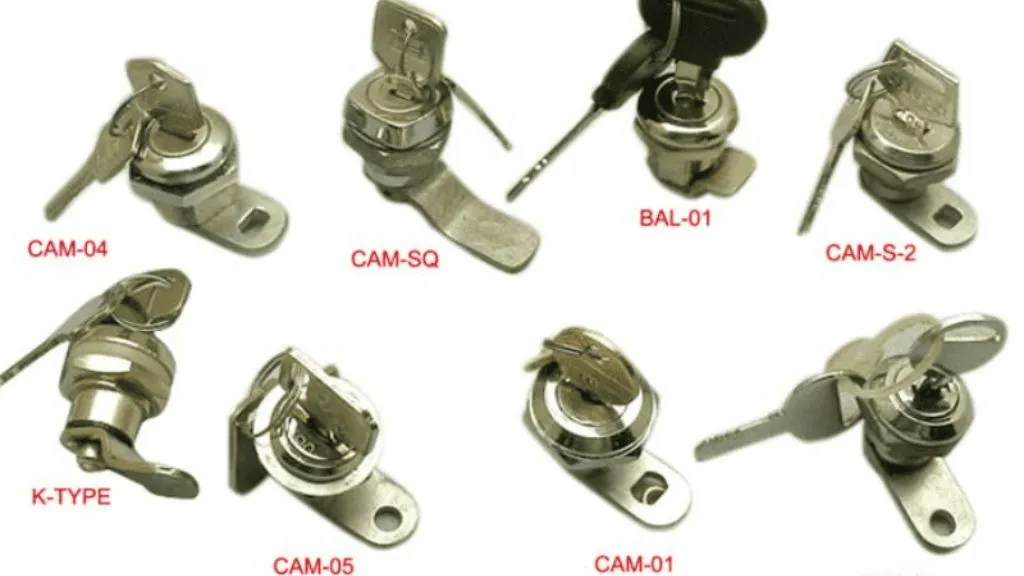
Cam locks are handy little devices used to secure cabinets, drawers, mailboxes, and more. They come in various types based on their mechanisms, each with unique features and ideal use cases. Here are some different types of cam locks and how you can use them:
5.1 Keyed Cam Locks: These locks operate with a traditional key. You insert the key, turn it, and the lock opens. They’re suitable for securing personal lockers, filing cabinets, or any small enclosures where you want to control access.
5.2 Combination Cam Locks: Instead of a key, combination cam locks use a numerical code. You set the code by turning the dials to your chosen numbers, and the lock opens when you enter the correct code.
5.3 Tubular Cam Locks: Tubular cam locks use a tubular key with a cylindrical shape. Tubular cam locks are commonly used in vending machines, coin-operated laundry machines, and arcade games.
5.4 Drawer Cam Locks: They often come with a spring-loaded mechanism that allows you to push in the lock and turn the key to secure the drawer.
5.5 Cam Locks with Keyed Alike: Keyed alike means multiple locks can be opened with the same key, while keyed different means each lock has its own unique key. Choose keyed alike for convenience in situations where you want one key to open multiple locks (e.g., multiple file cabinets). Opt for keyed differently for added security when each lock should have a unique key (e.g., mailbox clusters).
6. Padlocks
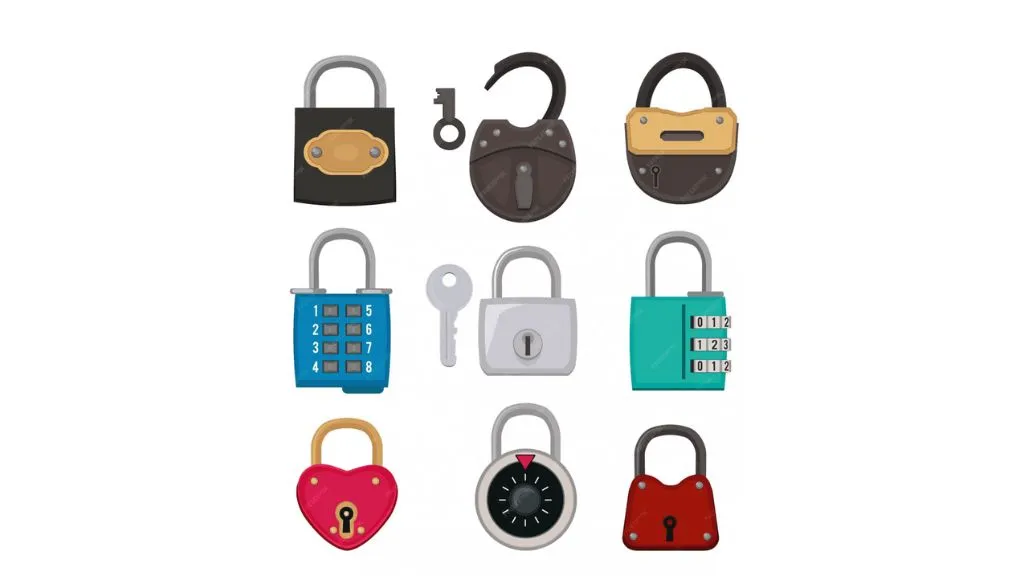
Padlocks are common types of door locks that can be detached from the door. They come in different sizes in two main categories:
6.1 Key Padlocks: These padlocks require a specific key to unlock them. They provide a high level of security because only those with the correct key can open them. Keyed padlocks are often used for securing gates, doors, toolboxes, and more.
6.2 Combination Padlocks: These padlocks are opened by entering a preset combination of numbers or letters. They are convenient because you don’t need a key, but you must remember the combination. Combination padlocks are commonly used for lockers, gym lockers, and luggage.
6.3 Shackless Padlocks: Shackleless padlocks do not have the traditional U-shaped shackle, which makes them more resistant to bolt cutters and saws. They are commonly used in high-security situations, such as securing containers or gates.
6.4 Bluetooth-Enabled Padlocks: These padlocks can be controlled using a smartphone app via Bluetooth. They provide features like remote unlocking, access sharing, and activity tracking. Bluetooth padlocks are used for modern, tech-savvy security needs.
6.5 Disc Detainer Padlocks: Disc detainer padlocks employ a set of rotating discs or plates that must be aligned in a specific way to open the lock. They are known for their resistance to picking and manipulation, making them suitable for high-security needs.
6.6 Tubular Key Padlocks: These padlocks have a circular key that fits into a tubular-shaped keyway. When the key is turned, it aligns pins or discs to open the lock. Tubular keypadlocks are commonly used for vending machines and bike locks.
6.7 Time Lock Padlocks: Time lock padlocks allow access only during specific time intervals or within set timeframes. They are used for applications where access control is needed at certain times.
7. Lever Handles
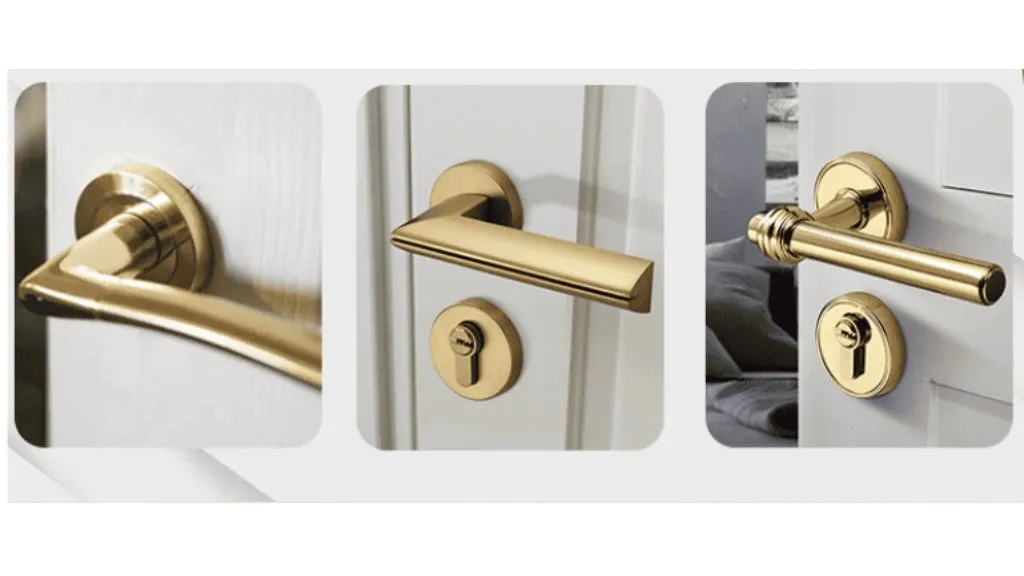
Lever handles are sizeable pushdown-style handles instead of a twisting style like the knob doors. Let’s check out the different types of lever handles:
7.1 Standard Lever Handle: They have a simple mechanism where you push down or press the lever to open a door. They have a simple mechanism where you push down or press the lever to open a door.
7.2 Return-to-Center Lever Handles: These lever handles automatically return to a horizontal position after you release them because of their spring-loaded mechanism. They are great for places where you want doors to close automatically, like in shopping malls or hotels.
7.3 Privacy Lever Handles: Privacy lever handles have a locking mechanism built in. They usually have a small button or turnpiece on one side to lock the door. To use them, you can lock the door from the inside using the button or turn piece, and it can be unlocked from the outside using a special tool or a small hole in case of emergencies.
7.4 Keyed Lever Handles: Keyed lever handles have a keyhole on one side, and you need a specific key to unlock them. Keyed lever handles are often used on entry doors for added security.
7.5 Electronic or Keypad Lever Handles: These lever handles use electronic keypads or card readers for access. Some even use biometric features like fingerprints. These are common in modern offices and smart homes.
7.6 Anti-Ligature Lever Handles: These lever handles are designed to prevent people from tying things to them to create a hazard. Anti-ligature lever handles are mainly used in healthcare facilities and detention centers to ensure the safety of occupants.
Endnote
The types of door locks you choose can make a significant difference in your home security. By considering your needs and following the installation steps for your selected lock, you can safeguard your home effectively. Prioritize your safety and make an informed choice when it comes to door locks.






